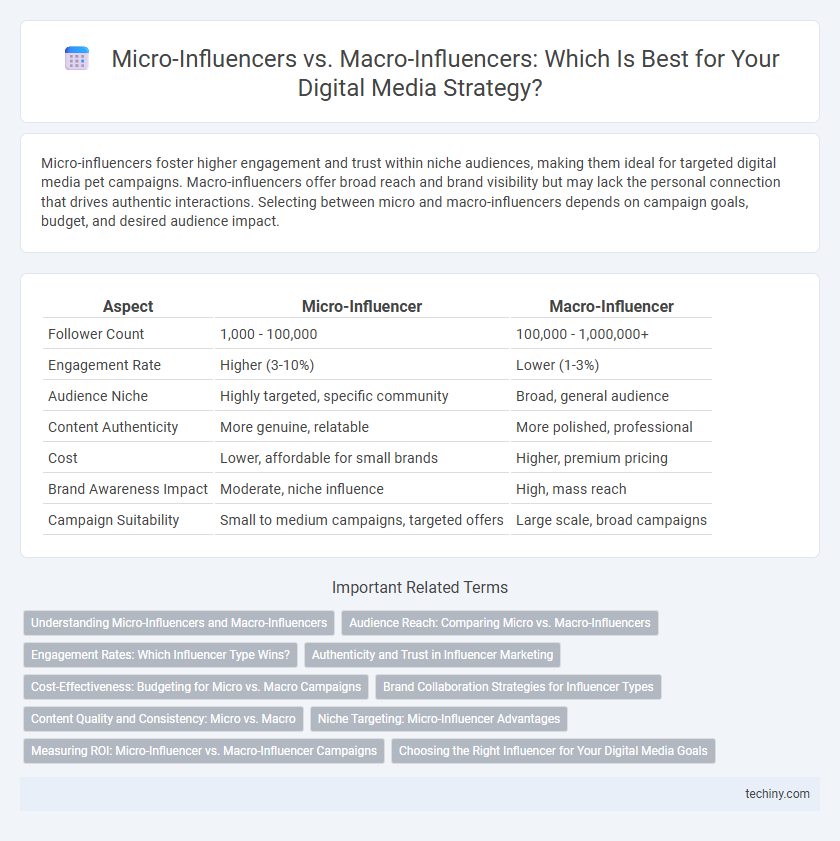Micro-influencers foster higher engagement and trust within niche audiences, making them ideal for targeted digital media pet campaigns. Macro-influencers offer broad reach and brand visibility but may lack the personal connection that drives authentic interactions. Selecting between micro and macro-influencers depends on campaign goals, budget, and desired audience impact.
Table of Comparison
| Aspect | Micro-Influencer | Macro-Influencer |
|---|---|---|
| Follower Count | 1,000 - 100,000 | 100,000 - 1,000,000+ |
| Engagement Rate | Higher (3-10%) | Lower (1-3%) |
| Audience Niche | Highly targeted, specific community | Broad, general audience |
| Content Authenticity | More genuine, relatable | More polished, professional |
| Cost | Lower, affordable for small brands | Higher, premium pricing |
| Brand Awareness Impact | Moderate, niche influence | High, mass reach |
| Campaign Suitability | Small to medium campaigns, targeted offers | Large scale, broad campaigns |
Understanding Micro-Influencers and Macro-Influencers
Micro-influencers typically have follower counts between 10,000 and 100,000, offering highly engaged audiences and niche expertise, which results in higher trust and authenticity in digital media campaigns. Macro-influencers boast follower numbers exceeding 100,000, providing broad reach and brand visibility but usually experiencing lower engagement rates compared to micro-influencers. Brands leverage micro-influencers for targeted marketing strategies and authentic connections, while macro-influencers serve well for expansive awareness and large-scale promotions.
Audience Reach: Comparing Micro vs. Macro-Influencers
Micro-influencers typically engage audiences ranging from 1,000 to 100,000 followers, offering niche market penetration with high engagement rates. In contrast, macro-influencers boast follower counts exceeding 100,000, delivering extensive brand exposure and broad demographic reach. Brands prioritize micro-influencers for authentic community connections and macro-influencers for maximizing visibility across diverse audiences.
Engagement Rates: Which Influencer Type Wins?
Micro-influencers typically achieve engagement rates between 3% to 8%, significantly higher than macro-influencers whose rates often range from 1% to 3%. The increased authenticity and niche focus of micro-influencers drive more meaningful interactions, making them highly effective for targeted campaigns. Brands prioritizing engagement and conversion frequently opt for micro-influencers to maximize return on investment in digital media marketing.
Authenticity and Trust in Influencer Marketing
Micro-influencers typically generate higher authenticity and trust due to their smaller, more engaged audiences and niche focus, leading to stronger personal connections with followers. Macro-influencers, despite their broader reach, often face challenges maintaining genuine interactions, which can reduce perceived credibility in influencer marketing campaigns. Brands leveraging micro-influencers benefit from higher engagement rates and more targeted, trustworthy promotions.
Cost-Effectiveness: Budgeting for Micro vs. Macro Campaigns
Micro-influencers often provide higher cost-effectiveness for digital media campaigns, delivering greater engagement rates per dollar due to their niche audiences and authentic connections. Macro-influencers command larger fees, which can strain budgets but offer broader reach and rapid brand exposure across diverse demographics. Strategic budgeting balances these factors by allocating resources to micro-influencer collaborations for targeted impact and macro-influencers for expansive visibility, optimizing overall campaign ROI.
Brand Collaboration Strategies for Influencer Types
Micro-influencers typically engage niche audiences with high authenticity, making them ideal for hyper-targeted brand collaborations that drive deeper community trust and higher engagement rates. Macro-influencers offer extensive reach and brand visibility, suitable for broad campaigns aiming at mass awareness and rapid market penetration. Brands should tailor collaboration strategies by leveraging micro-influencers for personalized storytelling and macro-influencers for scalable promotion and brand elevation.
Content Quality and Consistency: Micro vs. Macro
Micro-influencers typically deliver highly engaging, niche-specific content with consistent posting schedules that foster authentic audience connections, leading to higher trust and relevance in their communities. Macro-influencers, while reaching broader audiences, often face challenges maintaining content consistency and personalized quality due to larger-scale collaborations and diverse brand partnerships. Prioritizing content quality and consistency, micro-influencers generally outperform macros in driving genuine engagement and targeted marketing effectiveness.
Niche Targeting: Micro-Influencer Advantages
Micro-influencers excel in niche targeting by engaging highly specific, loyal audiences within particular interests, resulting in higher engagement rates compared to macro-influencers. Their authentic content fosters stronger trust and credibility, making their endorsements more persuasive in specialized markets. Brands leveraging micro-influencers benefit from cost-effective campaigns with precise audience segmentation, driving better conversion rates in targeted digital media strategies.
Measuring ROI: Micro-Influencer vs. Macro-Influencer Campaigns
Micro-influencer campaigns typically yield higher engagement rates and more authentic audience interactions, leading to a better return on investment (ROI) in niche markets. Macro-influencers provide broader reach and brand visibility but often have higher costs and lower engagement per follower, which can dilute ROI efficiency. Analyzing conversion metrics and engagement quality is essential to strategically allocate budgets between micro and macro influencer marketing for optimized digital media outcomes.
Choosing the Right Influencer for Your Digital Media Goals
Micro-influencers typically have follower counts between 10,000 and 100,000, offering higher engagement rates and more niche, targeted audiences ideal for brands aiming at authentic connections within specific communities. Macro-influencers possess audiences exceeding 100,000 followers, providing broad reach and brand visibility suitable for campaigns focused on widespread awareness and large-scale impact. Evaluating campaign objectives, audience demographics, and budget constraints helps determine the optimal influencer type to maximize ROI in digital media marketing strategies.
Micro-Influencer vs Macro-Influencer Infographic

 techiny.com
techiny.com